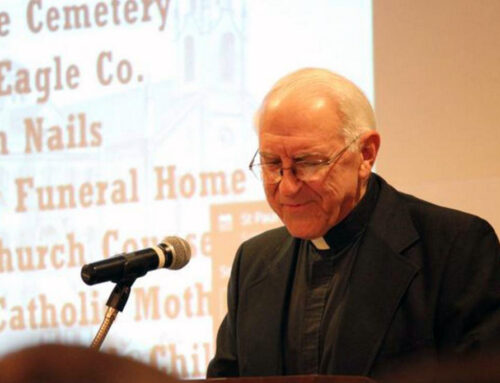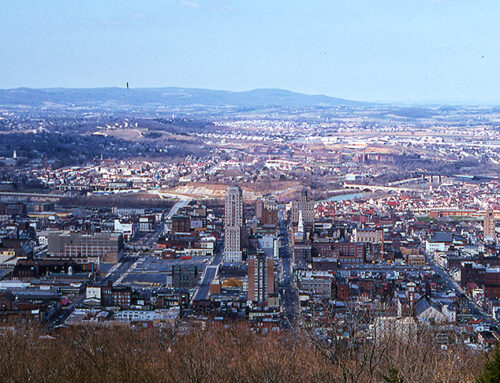Development from the City Charter till 1874, when Reading received a new charter and became a City of the Third Class, progressed steadily and through the same forces which guided it prior to 1847.
Population increased from 15,743 in 1850 to 23,162 in 1860 and 33,930 in 1870; more than doubling in twenty years. Many of the new residents were foreign immigrants attracted by stories of lucrative employment with American industries, and by the disruptions of economy and lifestyle which plagued Europe in the mid-19th Century. A sizeable portion of the immigrant population at this time was Irish, refugees of the Irish Potato Famine of 1845-1850. Both Germany and Italy waged long wars of unification during the 1860’s. By 1870, 11.4% of Reading’s total population had been born outside the United States and over two thirds of these had been born in Germany. Most of the newcomers found work as laborers in the City’s large manufactories and lived in recently-developed neighborhoods near the factories in which they worked, largely in South Reading. The Market Square area continued to be the fashionable part of town, while lower-income laborers lived near factories on the fringes, and beyond this the outlying estates were being invested in more for their value as areas of potential development than as residential estates or farmland.
The City boundaries were extended three times during this period. A survey between Reading and Alsace Township in 1858 extended the boundary to include much of what is now East Reading; at that time it was largely forest with some farms. Even more of East Reading was acquired when the boundaries were extended in 1867, at which time the northern boundary was also reset on a compass-point axis, just above the present Union Street. In 1869 the northern city line was again extended, to just above the present Berks Street, along the southern edge of the Alsace Lutheran Church graveyard.
Evidently the 1867 extensions were manipulated so as to more readily allow for the implementation of a compass-point grid system for city streets. Before the Civil War, Reading had no real long-range plan for the development of the entire city. As developers bought vacant lots, the City would install sections of east-west or north-south streets to fill in between the old non compass-point roads; so that as late as 1860, the City Fathers were still attempting to work First Hockley Alley, Second Hockley Alley, Bronson’s Alley, Lardner’s Alley, New Street (the former Coaler’s Lane), and the old Kutztown Road, among others, into the development of the City. Quite a few proposed neighborhoods never materialized. For example, a map of 1857 shows a layout of ‘North Reading,’ a neighborhood which was to extend approximately from the present Robeson Street eight blocks northward between the old Kutztown Road and the P & R Railroad tracks.
Soon afterward, the City Fathers decided that such a patchwork system of development would hinder Reading from becoming bigger and more prosperous. In 1864 a Mr. J. Lightfoot, a civil engineer from Philadelphia was employed to conduct a topographical survey of the City in order to permanently survey and fix the lines and grades of the streets, resulting in an overall plan for Reading. The survey was completed and the plans formalized in 1868.
The final plan of 1868 placed the entire City on a compass-point grid system, except for the area west of Kissinger Street (Schuylkill Avenue), which utilized the 70-degree-angle system. Every other 70 degree street which had not yet been developed or was not a major county road was to be eliminated as its surrounding area took shape. Plans for the eventual installation of east-west streets from Greenwich through Union and of northwest-southwest streets west of Kissinger were formalized. There were a few optional proposals which were not formalized: the continuation of Seventh Street and the east/west streets above Oley across the railroad yards, and the residential development of park land between Washington and Walnut in Penn’s Commons. The north/south streets west of Front were not named until the late 1870’s. The survey also raised the status of the half-streets, increasing their standard width to about twice what it was for the ‘alleys’ of the already developed sections. In fact, an easy way to see the extent of Reading around 1870 is to observe where various north/south half-streets become wider. Finally, the survey resulted in the alteration of election wards: the number of wards was raised from five to nine, and each of those nine was assigned a number.
The new plan for the City brought to light the fact that the railroads were becoming serious geographic barriers, especially in the North, where by the end of the Civil War there was no public thoroughfare above Elm Street which crossed the railroad yards. At the same time this area, especially the Northeast, was becoming more industrialized. It was obvious that swift residential development was soon to follow. By 1874 the railroad yards had been so extensively developed that only one cross street, the underpass at Oley Street, existed, allowing Northeast Reading and Northwest Reading to soon become very different places in everyone’s mind.
A new railroad line, the Lebanon Valley Railroad, began construction between Reading and Harrisburg in 1853. It became a part of the Philadelphia and Reading Company in 1857, and one year later trains began to run on the line. The Lebanon Valley Railroad proved to be a great asset to small industries which soon located along the line, which ran to the north of the Great Hollow in Northwest Reading. Yet another line was completed between Reading and Allentown by the Last Penn Railroad Company in 1859, and was taken over by the P & R in 1869. Reading was now on the shortest transportation route from the West to New York City, with connections to the entire Nation, and was no longer under the economic domination of Philadelphia. The Philadelphia and Reading was one of the major railroads of the Nation. The railroad shops and mills were extended all along the lines. A huge complex of car shops was built near Sixth and Oley in 1864. Around 1868 a large rail mill was constructed just beyond the City limits near Ninth and Exeter.
The large number of laborers needed to man these two establishments created a need for housing where, in both cases, there was none. Therefore small, isolated neighborhoods of inexpensive housing were begun on Sixth Street and Church Street between Oley and Spring, and along the last few blocks of North Ninth. A similar neighborhood, rather apart from the bulk of the City, was called Ricktown, located within the triangle bounded by Kissinger Street (Schuylkill Avenue), First Hockley Alley (West Elm) and the Schuylkill Canal. It was developed between the mid -1850’s and mid-1870’s by the Rick Brothers, whose hardware manufactory was located nearby. These dwellings housed the laborers of various Northwest Reading industries.
The most extensive development during the period was in the Southeast, most of it once again characterized as laborers’ housing. This area saw a great influx of Irish immigrants after the Potato Famine, especially during the 1850’s and 1860’s. By the beginning of the Civil War, the area centering on Spruce and Muhlenberg Streets east of the railroad was commonly known as ‘Irishtown.’ By 1874 residential development had extended about as far east as South Twelfth Street. Northeast development had reached to North Twelfth and Buttonwood Streets. The Northwest, except for Ricktown and the Oley Street Railroad Shop neighborhood, was still stranded at the Great Hollow.
Industry continued to grow with the railroads in all quarters of the City. Seyfert, McManus & Company at the foot of South Seventh Street, erected a new pipe mill in 1848 and a foundry in 1854. The future Reading Hardware began in 1851 as a blacksmith shop operated by William Harbster on Canal Street near Fifth, and one year later evolved into Harbster Brothers Hardware Company. A large cotton mill owned by the Reading Manufacturing Company began operations at Ninth and Cotton in 1852 and employed many residents of its immediate area. Jackson Rope moved to Ninth and Oley Streets in 1862, after a severe flood damaged their Canal Street factory. Sternbergh Bolt and Nut Works was established at Third and Buttonwood Streets in 1865. Reading Stove Works opened in 1866 on Canal Street between Chestnut and Spruce. Reading’s first major paint manufactory, A. Wilhelm & Company, moved into Reading from Easton in 1871 and located on Poplar beyond Walnut. In 1872 the Union Iron Foundry began operations in the extreme Northwest, at the foot of Exeter Street.
Below: Reading Bolt and Nut Works, 4th and Buttonwood Streets.

Amid all this expansion, the railroads completely supplanted the function of the canals, with their greater speed, lower prices, and lower maintenance costs. The establishment of the Lebanon Valley Railroad to Harrisburg in 1858 rendered the Union Canal hopelessly obsolete, and despite occasional improvements, the situations of both canals deteriorated rapidly, until by 1870 there were virtually no canal boats in operation and Reading’s officials were complaining of the health hazards posed by the stagnant water. Railroad track was laid all the way down Canal Street and up River Road to provide transportation for the industries which had depended on the canals. The river faded from people’s minds as a major part of Reading.
The orientation of the City was just beginning to change. Market Square was becoming less and less the geographic center of Reading, although it was still the hub of the City commercially, culturally, and residentially. However, as residential development extended northward, the railroad created an axis in people’s minds much as Penn Street did. In addition, the City finally removed the dilapidated market houses from the Square in 1871. They were replaced with four substantial brick markets; one for each of the four quarters of the City. Market Square was renamed Penn Square and although no one objected, the Square lost its identity as a domestic gathering place.
There were more than 6,300 buildings constructed in Reading from 1848 through 1874. A record 509 buildings were erected in 1868. By 1874 more than half of Reading’s buildings were made of brick. The rowhouse had become the rule in dwelling construction, and the erection of entire blocks of identical or similarly designed houses was becoming commonplace. Wealthy citizens preferred rowhomes as well, but called them townhouses. Most dwellings were built by contracting firms who made the initial investment, then sold the houses to citizens, sometimes on credit. A new type of building establishment was conceived during this period, however. Savings and loan societies came into vogue during the 1840’s, providing an efficient, inexpensive way for working-class residents to save and borrow. In 1866, one of these, the Union Building Association, was organized with the added purpose of constructing and selling laborers’- type housing on an easy financial plan. Home buyers would pay off their new houses in installments much as they would deposit money into a savings account, with the result that many workers could afford to buy a solid, comfortable house, and own it in a relatively short period of time. Some building associations were actually organized by major industries to facilitate the development of the neighborhoods around their factories. By 1874 there were about two dozen building associations in Reading. They erected a small portion of the City’s dwellings, but were beginning to come into prominence for their capacity in making home ownership accessible to the average worker.





